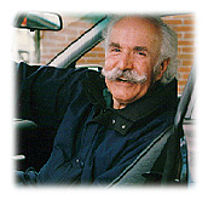2004 Donald O. Hebb Distinguished Contribution Award Winner: Dr. Vincent Di Lollo

Vincent Di Lollo is recognized in the international scientific community as a leader among researchers of cognitive systems. In pursuing his program of research in these fields, he has displayed ingenuity, insight, and creativity to an outstanding degree. His practical and conceptual contributions have added in significant and fundamental ways to our understanding of perception and cognition.
Born in Gorizia, in the Italian north-east, Vince became a World-War II refugee and was transported to Australia along with his parents, two brothers, and a shipload of other refugees from Eastern Europe. A hiatus as miner, construction worker, and barman then followed during which Vince studied for, and won, a scholarship to attend the University of Western Australia, where he earned a Bachelor's degree with honours in Psychology (1959) and a Ph.D. (1962). In 1962 he was awarded a Fulbright Fellowship to work at the Universities of Michigan, Indiana, and Princeton.
Back at the University of Western Australia in 1965, Vince progressed rapidly from Lecturer, to Senior Lecturer, to Reader in Psychology. In 1975 he moved to Canada, first to the University of Manitoba (1975-78), then to the University of Alberta (1978-96), and most recently to the University of British Columbia where he is Honorary Professor of Psychology.
Early in his career, Vince divided his research activities among the ostensibly unrelated fields of animal learning, human psychophysics, and human visual perception. He published extensively in all three fields, but the exquisite temporal and spatial resolution afforded by the increasingly available minicomputers in the early 1970s nudged him decidedly towards research in vision.
In the ensuing decade, Vince became best known for his definitive contributions to our understanding of iconic memory, which refers to the continued visibility of an image for a brief period after the physical stimulus has been turned off. In a brilliant series of studies, Vince demonstrated that the duration of iconic memory is related inversely to both the duration and the intensity of the inducing stimulus. These findings led to the rejection of the then widely held sensory storage theory of iconic memory and to its replacement with an information-processing model. In a survey conducted by the American Psychological Society, this work was listed among the contributions that triggered the most significant changes in the direction of psychological research in the twentieth century.
Beyond the work on iconic memory, Vince has addressed the more general issues of temporal integration and segregation of trains of visual stimuli as seen in such everyday events as TV and cinematic motion sequences. In an elegant series of experiments, he showed that whether sequential stimuli are perceived as temporally integrated or disjoint depends not on the availability of visible persistence but on the temporal correlation between bursts of neurophysiological activity produced by the sequential stimuli within the visual system. A quantitative version of the temporal-correlation theory has provided a coherent account of hitherto confusing patterns of experimental outcomes.
As a natural evolution of the temporal correlation theory, Vince and his colleagues at UBC have questioned the conventional view of how incoming stimuli are handled in the visual system, and have proposed a profoundly different new view. In the conventional view, visual perceptions are said to emerge from a sequence of discrete processing stages within the visual system. The sequence is regarded as being mainly feed-forward, with processing advancing from simple to increasingly complex attributes, along brain pathways that converge to a common area in which conscious perceptions occur. Vince and his co-workers have shown how this conventional view is disconfirmed both by recent advances in neuroscience which implicate reentrant signaling as the predominant form of communication between brain areas, and by a new form of visual masking, called object-substitution masking discovered in their laboratories.
Replacing the conventional view, Vince and his group hold to a scheme in which perceptions emerge from iterative exchanges between brain regions linked by reentrant pathways. In this scheme, cortical feedback has two main functions: a) to test for specific patterns in the activity at the lower level, and b) to reconfigure the same neurons at the lower level so that they can perform very different operations at different stages of the processing cycle. This line of research draws extensively from the fields of visual attention, computer modeling, and event-related potentials. Laboratories across the world are now employing these techniques to further test and develop a reentrant theory of visual perception.
In addition to enhancing Canada's scientific prominence on the world's stage, Vince has served the Canadian academic community unselfishly in scientific advocacy and in the shaping of national science policy. He has served on the Psychology: Brain, Behaviour and Cognitive Science Grants Selection Committee (GSC-12) of the Natural Sciences and Engineering Research Council of Canada for a total of eight years, twice as Committee Chair. Over this entire period, he played a critical role in maintaining the membership of Psychology within the life sciences funded by NSERC. He is notably active in national and international societies, and served as President of the Canadian Society for Brain, Behaviour, and Cognitive Science (1996-97). He is a former Editor of the Canadian Journal of Psychology, and a member of the editorial board of several distinguished international journals. In recognition of his scientific achievements and public service, Vince has been elected to Fellowship of the Royal Society of Canada.
As one of the country's leading cognitive scientists, Vince richly deserves the Donald O. Hebb Distinguished Contribution Award of the CSBBCS. It is a fitting recognition of his many accomplishments and of his service to our community.

